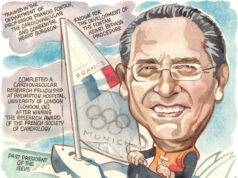
While more than 60% of medical students are female, the number of women in endovascular medicine is low, report Bella Huasen and Agnieszka Solberg. Here, for Vascular News, they discuss the reasons behind this under-representation and consider the importance of creating a global support network to redress the imbalance.
“What hubris it was, he said, that mankind should think to halve the powers of the human race by ignoring the minds and words of the female half of it”—The Clockmaker’s Daughter, Kate Morton.
Charles Dotter’s first superficial femoral artery recanalisation in 1964 began a new era of endovascular medicine, a fairly new and evolving specialty compared to traditional career paths such as surgery or primary care.
The profession is practiced by multiple sub-specialists including interventional radiologists, vascular surgeons, angiologists, and interventional cardiologists. Despite the variation and interests, female trainee and consultants/residents remain under-represented in all of these specialities.
In the USA, fewer than 8% of interventional radiologists are women; in Europe fewer than 10%. The percentages are even more grim for vascular surgery, in the USA <6% and in Europe <8% are women. Despite >50% of medical students identifying as women in the USA and Europe, there is never a line to the ladies’ bathroom at endovascular medicine conferences.
This beautiful lifesaving carer should attract talent irrespective of gender. It is everyone’s responsibility to recognise this issue and encourage female doctors and students into this field. This is not as easy at is seems given the culture of misogyny and sexism engrained in cultures throughout the globe.
Conscious bias still exists in 2020 and trainees are still being told that endovascular medicine is not for them, based solely on the fact that they are women. Most of the time, however, this behaviour is unconscious and, sadly, it is prevalent in both men and women.
Many females have contributed to this field starting with Marie Curie-Sklodowski for the use of X-rays, yet the gender disparity is rife across the globe. When searching congresses, conferences, proctors, panels, and faculty members; the site or inclusion of females is rare if not none-existent.
We have attended multidisciplinary endovascular conferences with hundreds of attendees, but limited women speakers, chairs or panellists. Surely, there are qualified women endovascular specialists who can provide some insight.
Given the benefits of a diverse workforce and the effectiveness of female physicians compared to their male colleagues in respect to mortality rates and other outcomes (Tsugawa et al 2017; Wallis et al 2017), all specialities should be recruiting female physicians to join their teams.
The benefits of a diverse workforce are well known inclusive companies outperform the S&P 500 index, attract top talent rich in creativity and innovation, and can better anticipate a broad range of customer needs (Spalluto 2018).
Since women make over 90% of their family’s healthcare decisions (Spalluto 2018), female doctors have an edge at understanding and meeting the needs and expectations of the female health care consumer. As the minimally invasive options for patients grow to include gynecologic, urologic, gastrointestinal and breast procedures, female patients are likely to more often request a female physician.
One of the ways to increase the number of women in endovascular medicine is to provide trainees with more role models. Representation matters but there is a striking disparity between the genders in leadership positions in medical schools despite more female medical students; women represent a small fraction of medical school deans and full professors.
This is not occurring because women are uninterested in leadership positions; it is occurring because women are not being considered and not being selected for these positions despite having equal or higher qualifications than their male colleagues.
Many organisations have begun women’s sections to help combat biases and improve the representation of women in their societies. The Society of Interventional Radiology, for example, has a very active women-in-IR (WIR) section which meets monthly. There is also dedicated WIR programming at the annual SIR conference.
Multidisciplinary organisations (ISET, OEIS, VIVA, GEST, etc) tend to be smaller and have few, if any, women physicians in planning and execution of the annual event as well as a smaller percentage of women speakers and even attendees.
Grassroots organisations have tried to raise awareness about these discrepancies; however, it is challenging to enact any change without having adequate representation on the boards.
We met through “RadChicks” in interventional radiology and shared a passion for motivating females into interventional radiology. We work hard from both sides of the Atlantic to support and encourage this change as well as offer medical students and junior doctors’ opportunities to discover this fields as well as support those already in training.
Our main focus is twofold: 1. coordinate in our advocacy efforts for women in radiology/endovascular medicine and 2. provide platforms where medical students and student doctors/residents feel supported, including mentorship/sponsorship programs, book clubs/workshops on a myriad of topics, networking events, even anonymous counselling.
When women trainees see strong women in their field, even in another state/county or across the globe, they feel empowered. They are not only empowered to continue in their path, but they feel empowered to help other women and under-represented minorities. This chain reaction becomes a powerful global support network which one day will improve the representation of women in endovascular medicine.
Bella Huasen is a consultant interventional radiologist at Lancashire Teaching Hospitals NHS Foundation Trust in Preston, UK.
Agnieszka Solberg is a vascular and interventional radiologist at CHI St Alexius Health in Bismark, USA.













